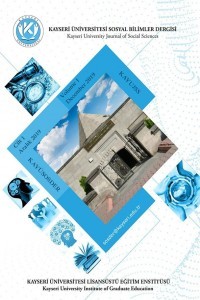New York Metropolitan Müzesi’nde bulunan 15.yüzyıla ait Mushaf-I Şerif’in tezyinatı
Geleneksel Türk Sanatları içerisinde önemli bir yere sahip olan Türk tezhip sanatı, Anadolu topraklarına Selçuklular yoluyla gelmiş ve Osmanlı’da zirve dönemini yaşamıştır. Selçuklu Dönemi ve Osmanlı Dönemine bir alt yapı oluşturmuş, o döneme has üslup sürekli geliştirilerek devam etmiştir. Altın ve dönemlere göre muhtelif renklerin uygulandığı tezhip sanatının gelişimi; Türk İslam medeniyetinde Mushaf-ı Şerif’e verilen değer ve saygı neticesinde onu en güzel bezeme isteği doğrultusunda ilerleme göstermiştir. Mushaf’ların genellikle zahriye sayfaları, serlevhaları, sûrebaşları, hatime sayfaları, durak ve gülleri dönemin zevk ve beğenisi doğrultusunda en güzel örnekleriyle tezhiplenmiştir. Bu doğrultuda oluşturulan birçok nadide eser günümüze ulaşmıştır. Bu araştırma, tarama modelinde bir betimleme çalışmasıdır. Araştırmada, New York Metropolitan Müzesi 68.179 erişim numarasıyla açık erişimde yer alan 15. Yüzyıla ait Mushaf-ı Şerif’in tezhip özelliklerinin incelenmesi amaçlanmıştır. Müzeyyen tezhipli sayfaların renk, motif ve kompozisyon özellikleri incelenerek açıklanmış, bugünkü durumu belirlenmiştir. İncelenen Mushaf’ta uygulanan tezyinat, dönem özellikleri doğrultusunda karşılaştırmalı olarak değerlendirilmiştir. Araştırma sonucunda incelenen Mushaf’ın Beylikler Dönemine ait bazı yazma eserlerdeki bezemelerle ve Fatih Dönemi “Baba Nakkaş üslubu” olarak bilinen üslupla benzerlikler gösterdiği tespit edilmiştir.
Anahtar Kelimeler:
Beylikler Dönemi, Mushaf Tezyinatı, Baba Nakkaş, Tezhip
The illumination of the 15th century Mushaf-I Sharif found in the New York Metropolitan Museum
Turkish illumination art, that has a significant place in Traditional Turkish Arts, came to Anatolian lands through the Seljuks and experienced its peak period in the Ottoman Empire. The Seljuk Period formed an infrastructure for the Ottoman Period, and the style unique to that period continued as being constantly developed. The development of the art of illumination in which gold and various colors are applied according to the periods; has improved in line with the desire to decorate it in the most beautiful way as a result of the value and respect given to Mushaf-ı Şerif in Turkish-Islamic civilization. Generally, zahriye pages (bookback page), serlevhas (front page), surah titles, hatime pages (last page), ceasura (period between verses), and roses of the Mushafs were illuminated with the most beautiful examples in line with the taste of the period. Many rare work of art created within this framework have survived to the present day. This research is a descriptive study with a scanning model. In the current research, it is aimed to examine the 15th century Mushaf-ı Şerif, which is in an open access with the New York Metropolitan Museum access number 68.179, in terms of its illumination features. Their current status was determined by examining the color, motif and composition features of the Müzeyyen illuminated pages. The ornaments applied in the examined mushaf were evaluated comparatively in line with the characteristics of the period. As a result of the research, it was determined that the examined Mushaf, showed similarities with the decorations in some manuscripts belonging to the Beyliks Period and the style known as the "Baba Nakkaş" style of the Fatih Period.
Keywords:
Beyliks Period, Mushaf Illumination, Illumination,
___
- Arseven, C. E. (1984). Türk Sanatı. Cem Yayınevi.
- Aksoy, Z. D. (2010). XIV. Yüzyıl Anadolu Türk Tezhip Sanatı Tasarımları (Tez No. 274485) [Doktora Tezi, Mimar Sinan Güzel Sanatlar Üniversitesi]. Yükseköğretim Kurulu Ulusal Tez Merkez’inden edinilmiştir.
- Aşıcı, S. (2015). Kitap Dostu Bir Sultan: Fatih. Hat ve Tezhip Sanatı, (A. R. Özcan, ed.), Kültür Bakanlığı Yayınları, 437-449.
- Binark, İ. (1969). Tezhib Sanatı ve Kitapçılık Tarihimizde Fatih Devri Tezhipleri, Türk Kültürü Araştırma Enstitüsü, 75(VII). 220-233.
- Duran, G. (2014, 20-26 Eylül). Mushafların Bezenmesinde Tezhip Sanatının Önemi ve Katkıları. III. Uluslararası Türk Sanatları, Tarihi ve Folkloru Kongresi/ Sanat Etkinliklerinde sunulan bildiri, (ss.133- 138), Delhi- HİNDİSTAN.
- Detseli, N. ve Baysal, A. F. (2019). Rodos’ta 1455 tarihli bir Mushafın tezhipleri ve bulut motifi. Sanat Tarihi Dergisi, XXVIII (2), 437-453. DOI: 10.29135/std.589426
- Özçelik, B. (2020). Fatih Albümü’nde Kullanılan Baba Nakkaş Üslubu Motiferin Çini Sanatına Yansıması (Tez No. 690230) [Yüksek Lisans Tezi, Sakarya Üniversitesi]. Yükseköğretim Kurulu Ulusal Tez Merkez’inden edinilmiştir.
- ISSN: 2687-5772
- Yayın Aralığı: Yılda 2 Sayı
- Başlangıç: 2019
- Yayıncı: Kayseri Üniversitesi
Sayıdaki Diğer Makaleler
Makâlât adlı eserinde Şems-i Tebrîzî
Plotter sanatı ve bu alandaki yeni yaklaşımlar
Son dönem Osmanlı tezkirecilerinden Çaylak Tevfik ve Siyer-i Nebîsi (inceleme-çeviri yazı)
Murat BIYIKLI, İsmail YILDIRIM
New York Metropolitan Müzesi’nde bulunan 15.yüzyıla ait Mushaf-I Şerif’in tezyinatı
